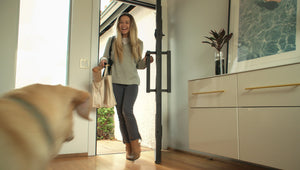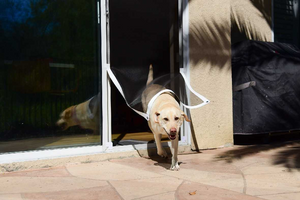Cold Weather and Your Dog Doors
Once autumn hits, plenty of pet owners start to worry about cold air and rain getting into their homes through their pet door. A dog door that isn't well-insulated can leave your home vulnerable to cold drafts and wet weather, which can cause your heating bills to sky rocket. Your best bet will be to winterize your dog door.
But you may be wondering: how do you winterize a pet door effectively? There are a number of ways to keep the cold out, and our guide provides plenty of tips, such as:
- How to Check Your Flaps
- Knowing If Your Insulation or Weather Stripping Needs Replacing
- Knowing When to Upgrade to a Cold Weather Pet Door
Check Your Flaps
Older flaps can still be physically intact, but they may be not sealing properly. This even goes for "all-weather dog doors" and "extreme weather pet doors." Always check to see if there are gaps forming at the edges. This means that cold air is going to come into your house. Any light you see coming through the sides of the flap is going to translate to heat leaving your house.
Check out this large selection of replacement flaps.
You may also need to upgrade your flap. A pet flap with effective weather protection typically:
- Has magnets that will seal your door shut against wind
- Has a dual flap system to help keep out cold air
- Is made from water-proof material like rubber or plastic
- Is made from sturdy material so that is closes more securely
If the flap on your pet door doesn't have these features, then it may be time to upgrade to one that will keep the winter weather out of your home.
Does your Insulation or Weather Stripping Need Replacing?
Sometimes the flaps are just fine, and it's the weatherstripping that fails. For older panels or where a lot of direct sunlight hits the draft stoppers or weatherstripping, you may need to replace the affected materials a bit more frequently. The best way to tell is to feel along the gaps for drafts and cold.
Magnetic weather stripping is also available as a quick, temporary draft fix, but we find that dogs can more easily rip the magnet off while using the door compared to traditional, stick-on weather stripping.
If your pet door is installed into your door or wall, you may need to use silicone caulk to seal-up any holes between the frame and the door or wall. This will block any cold air from getting inside.
It May Be Time to Upgrade
If you have had a pet door for 15 years, chances are high that the technology has made leaps and bounds in terms of energy efficiency and insulation. Living in colder climates or having harsher winters can necessitate the need for dual flaps or more insulated flaps to keep it warm inside.
These days, there are lots of extreme weather dog door options. If you have a slider insert, then you may want to look into dual-pane glass, as the glass itself can allow for insulation loss if it is only a single pane. If you wish to upgrade, check out the best dog doors for cold weather.

As far as the cold weather goes, we did some testing on some of the most popular door brands on the market to see what flaps shrink in the cold or would blow open in the wind. You can see the video results below (on any given day you can find a flap or two in our freezer, it’s a weird break room):




